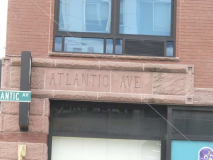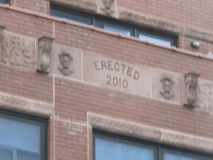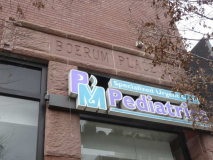The Cobble Hill, Boerum Hill, Carroll Gardens and Gowanus neighborhoods, arrayed south of Atlantic Avenue from 3rd Avenue west to the East River and north of the Brooklyn-Queens Expressway and Gowanus Canal. Each are relatively distinct: Cobble and Boerum Hills, comprising the few blocks south of Atlantic Avenue east or west of Smith Street respectively, feature block after block of Brooklyn’s most expressive and diverse residential architecture. Cobble Hill is Brooklyn’s second-largest Italian-American enclave after Bensonhurst, while rough and ready Gowanus, closest to its namesake canal, is the former haven of the Mohawk Indians who worked on Manhattan’s skyscrapers in the 30s till the 60s and beyond.
In December 2018 I thought it would be fun to walk down four separate Places in Cobble Hill that run between Kane and DeGraw Streets and Court and Columbia Streets: Tompkins, Strong, Cheever, and Tiffany. At one time, I harbored the notion that they were named for famous people I had heard of, such as diarist George Templeton Strong, author John Cheever, Vice President Daniel Tompkins, and the Tiffany family of jewelry and stained glass fame. In most cases, the reality is rather more prosaic. Also, only part of Cobble Hill is under Landmarks Preservation Commission protection, so my knowledge is limited on a some of what I’m seeing, so my descriptions will in the main be the “Look at that, isn’t that purty” ilk. Those aren’t the only streets I explored…
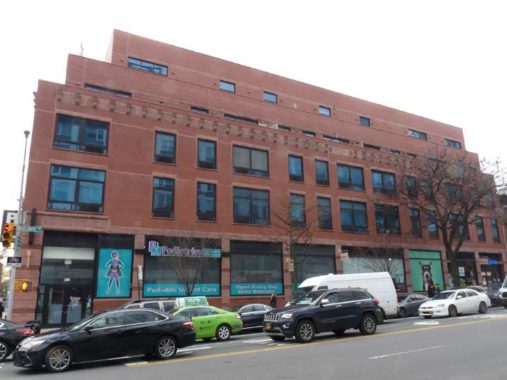
Here’s a relatively new office building at #240 Atlantic Avenue and Boerum Place. It bucks the recent trend of interchangeable panels with large windows and uses brick construction — and even brings back the old tradition of carving the intersectioned streets in the building corners! Just across the street is the Brooklyn House of Detention. I never remember anything being in this space but a parking lot.
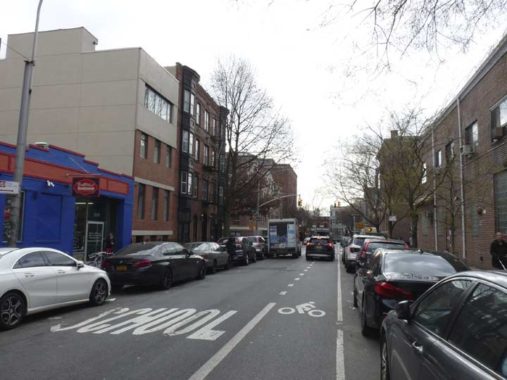
Boerum Place is the most schizophrenic street in Brooklyn. On its southern end, between Atlantic Avenue and Bergen Street, it’s a modest one-lane neighborhood street, but north of Atlantic, it (along with Adams Street, which it becomes north of Fulton) become six-lane behemoths funneling traffic onto the Brooklyn Bridge (there are some “Brooklyn Bridge Boulevard” signs). When the city razed much of the area around Fulton Street east of Court Street to create Cadman Plaza in the 1950s, Boerum and Adams were given steroids at the same time. Along with Schermerhorn Street (inexplicably pronounced “Skimmerhorn” by Brooklynites), Boerum Place is a reminder of Brooklyn’s Dutch colonial past. Many Boerums settled in Brooklyn, but this Place, and the Boerum Hill area, recall Simon Boerum, while Boerum Street in Williamsburg recalls Jacob Boerum.
Again, some new bricks, or at least faux bricks, with wood paneling at Boerum Place and Pacific Street. Maybe I’m nuts or I’m not the philistine I once was, but I don’t really mind this. Thoughts?
A trio of winners on the east side of Boerum between Pacific and Dean.
#120 Boerum Place at Dean Street was originally a factory (for what I do not know) and was converted to condominiums in 1983, with a jogging track on the roof (hence the name Skytrack).
More new bricks and wood paneling, this time on Dean Street off Boerum Place.
Vinnie’s Italian Art Iron Works, established in 1963 by Vincent Pampillonia, harks back to Boerum Hill’s industrial past. “For 48 years, Vinnie’s Italian Art has been specializing in the restoration and recreation of ironwork that can mostly be found in countless brownstones and landmark buildings throughout Brooklyn and Manhattan.” The iron works is accompanies on the south side of Bergen Street by a row of handsome woodframe buildings, an increasing rarity.
Dominating upper Cobble Hill is St. Paul’s – St. Agnes Church, a very old church built in 1838 and designed by Gamaliel King on land formerly owned by a furrier, Irish immigrant Cornelius Heeney, who served a a guardian to a boy named John McCluskey, who later became the USA’s first Cardinal. While Heeney donated some of his property to this church, he also donated some of his Manhattan Island holdings so that St. Patrick’s Cathedral in midtown could be built, and also donated pews and gallery fittings to St. Peter’s on Barclay Street in lower Manhattan – thus, Heeney had a hand in some of NYC’s oldest extant Roman Catholic buildings. Heeney is interred in the churchyard here.
Angela’s Ashes author Frank McCourt was baptized here in 1930 before his family returned to Limerick, Ireland in 1934. The co-parish, St. Agnes on Hoyt and Sackett Streets, is one of Brooklyn’s largest churches.
Believe it or not, I had never once walked on the dead-end section of Verandah Place, a former mews, that’s east of Clinton Street at Cobble Hill Park. Clearly, that situation had to be rectified.
A veranda or verandah, as it’s spelled here, is a roofed, open-air gallery or porch, attached to the outside of a building. A veranda is often partly enclosed by a railing and frequently extends across the front and sides of the structure. There may have once been verandas on this alleyway, but not anymore. It’s possible they were once found on the north side of the Place, which is now occupied by the 6-story residential towers at #200 and 210 Congress Street.
Three former stables, long ago converted to residences on Verandah Place east of Clinton. This stretch of the Place reminds me of Hunts Lane and Grace Court Alley in Brooklyn Heights, a bit to the north. These buildings went up between 1876 and 1878.
Verandah Place looking east toward Clinton Street.
This former stables has retained its old hayloft hoist.
Cobble Hill Park, between Verandah Place and Congress Street west of Clinton Street, is relatively new. Its area was formerly occupied by the Second Unitarian Church from the 1850s to 1961, along with a pair of old mansions. All were torn down before the LPC could designate the area, and they were replaced by a rubble strewn vacant lot. Plans were formulated to build a Bohack supermarket in this heavily residential area, and residents fought a pitched battle against it. They won out, and the land was rededicated to park use; Cobble Hill Park opened in 1965.
I decided to photograph every one of the small, 2-story brick dwellings, also former stables, along the south side of Verandah Place facing the park. All date from about 1845-1865, and many have their traditional brick fronts. The smallest of them is #40, which was cut back to make way for residences on Clinton Street in the 1800s. In 1931, it had a famous resident, North Carolinian Thomas Wolfe, of Look Homeward, Angel and Of Time And The River fame. “Only the dead know Brooklyn,” he wrote.
The most unusual house on Congress Street, with its Queen Anne dormers and turrets and nearly triangular bay windows, is #147 — it’s also one of the most recently built, going back to 1900 or so, just off Henry Street.
An imposing building indeed at 380 Henry between Warren and Congress, now the Cobble Hill Health Center but originally St. Peter’s Hospital. Consulting my Francis Morrone, I see that it was once associated with St. Paul’s/St. Agnes. It was constructed in 1888-1889, what must be the two greatest years in NYC architecture, by William Schickel & Company. The hospital closed in 1962, became a nursing home and was then subjected to the usual scandals that nursing homes undergo, as the elderly are sometimes considered nuisances in our society. The building was renovated in 1989 and attained its present use at that time.
#120-126 Congress, on the south side of the street between Hicks and Henry, are handsome attached brick dwellings going back to around 1880.
Meanwhile, #110-118 Congress make up a group of relatively new buildings that appear to be modern updates of the previously shown quartet. They are all on land formerly owned by the Roman Catholic Diocese of Brooklyn. These buildings were constructed in 2015.
Congress Street is bridged over the Brooklyn-Queens Expressway at Hicks Street. The BQE divided Cobble Hill into two sections when it was cut through the region in the late 1940s and early 1950s, as many homes along Hicks and the east-west streets were demolished to make way for it.
A remaining chunk of Brooklyn’s once-thriving shipping business can be found along Columbia Street between Atlantic Avenue and DeGraw Street, which serves to protect the view of Manhattan Island from there. The two tall buildings are part of the One Brooklyn Bridge Park complex at Atlantic Avenue and Furman Street.
#140 DeGraw Street at Tiffany Place is not a new building, but a radical transformation made possible because Cobble Hill west of the BQE is not under Landmarks guidelines. Unusually the whole exterior is essentially a bay and residents can have a three-way view. These days a 2-BR here sells for over $1M, but when it was first transformed in 2007 the cost was a “mere” $750K.
Tiffany Place, my favorite of the Cobble Hill Place Quartet because of its surviving Belgian Blocks, is likely thought by area denizens to be named for Louis Comfort Tiffany, but maps show it as early as the 1840s — long before the glassmaker ever built a factory in Brooklyn or elsewhere. There was a state senator from the area named George Tiffany in the early 19th Century, and that’s likely the source. You will find the famed Tiffanys in Brooklyn, though, since the family, including Charles Lewis of dry goods and later, jewelry fame, is interred in Green-Wood Cemetery.
As stated, I’m fascinated with Tiffany Place’s well-preserved paving stones. It’s the only street in the area, other than parts of Joralemon Street, that still features them. One of these days, I’d like to see a comprehensive NYC map indicating where the remaining Belgian blocked streets are.
Tiffany Place features prime examples of my favorite variety of NYC housing, attached brick construction. The street is outside the Cobble Hill landmarked district, so I wish I could find out more about these buildings.
#1 Tiffany Place, at the corner of Kane Street, is the largest of these brick houses on the street, and it is the building that caused the misconception about Tiffany Place being named for Louis Comfort Tiffany. Somehow, an idea got around (likely from real estate agents) that this was a Tiffany glass factory at one time. According to Lost City, the records don’t show it. The building had been home to Walther and Company, which produced “fancy papers” or paper used for wrapping or in wedding invitations. I was hoping the Belcher Hyde 1929 atlas would settle the issue, but it merely shows it as a large brick building.
Older maps show Kane Street as Harrison, and this chiseled sign at Cheever Place bears that out. The name was changed in 1928 to honor James Kane, a longtime local election commission alderman and police sergeant. Were a similar honor bestowed today, Harrison Street would likely have kept its name with James Kane honored on a separate sign.
Cheever Place honors Samuel Cheever (1787-1874) one of three commissioners who laid out the grid system of streets in this area. He was an attorney who hailed from upstate Saratoga County.
More attached brick buildings! The Greek Revival houses at #10, 12 and 14 Cheever were built in 1839.
These attached Italianate brick buildings went up in the 1850s. Not pictured are #43-45, built in 1873 as two of Brooklyn’s first apartment buildings.
When completed in 1852 this was the Early English Gothic Strong Place Baptist Church at DeGraw Street. The architect was Minard Lafever, who built other churches in the region, notably St. Ann’s at Clinton and Montague Streets. According to Francis Morrone, it was Lafever’s own personal favorite. About a decade ago (late 2000s) it was converted to residential.
Strong Place’s brownstones go back to between 1872 and 1892.
Two pairs of Queen Annes on Strong Place, #41-43, and #33-35, have retained their triangular bay window treatments. The new building shown above at #140 DeGraw takes this feature to the max, making the entire facade a triangular bay.
#20 Strong Place, from 1872, retains its slanted mansard roof topped by decorative ironwork.
Tompkins Place may or may not be named for NYS Governor and Vice President Daniel D. Tompkins (1774-1825) though Bedford-Stuyvesant’s and Rosebank, Staten Island’s Tompkins Avenues, as well as Tompkins Square Park and Tompkinsville certainly were.
It’s been shrouded under construction netting for a couple of years, but this historic building at Tompkins Place and Kane Street has been the Kane Street Synagogue since 1905, the oldest Jewish temple in the immediate area. The building was constructed in 1855 as the Middle Reformed Protestant Dutch Church.
One of these is not like the others! This Greek Revival row on the east side of Tompkins Place was built in the 1840s, with the mansard and dormer windows of #15 were likely added in the 1870s or 1880s.
Yet another stretch of beautiful brick buildings, the Italianate brick buildings at #22-28 Tompkins Place go back to the early 1850s.
Working back around to Court Street, I’ve aways been fascinated by this attached quartet, #194-200, which when built was collectively known as Foster Block. It’s a bit of nomenclature not generally employed in NYC, but when I was in Portland ME a few years ago, I noticed quite a few “blocks” meaning attached buildings. They have retained their usual entrances.
Back on Bergen Street east of Boerum Place, here’s a pair of stables turned residences at #48 and 52, separated by a church that may have been a stable itself.
Another bit of fascinating reuse is at #51 Bergen, where a former belt factory has become the Invisible Dog Art Studio:
The Invisible Dog Art Center is housed in a three-story former factory building in Boerum Hill, Brooklyn. Built in 1863, our 30,000 square foot facility has been the site of various industrial endeavors, most notably a belt factory that manufactured the famous Walt Disney invisible dog party trick, after which our center is named. The building remained dormant from the mid 1990s until 2009, when our founder Lucien Zayan opened The Invisible Dog.
The Invisible Dog is dedicated to the integration of innovation in the arts with profound respect for the past. In 2009, the building was restored for safety reasons, but special attention was given to the preservation of its original 1863 form. The rawness of the space is vital to our identity.
Regular Visitors is sort of a high-concept dry goods store at the corner of Smith and Bergen Streets; the corner also features an F train entrance, to which I went in.
Check out the ForgottenBook, take a look at the gift shop, and as always, “comment…as you see fit.”
2/3/19

